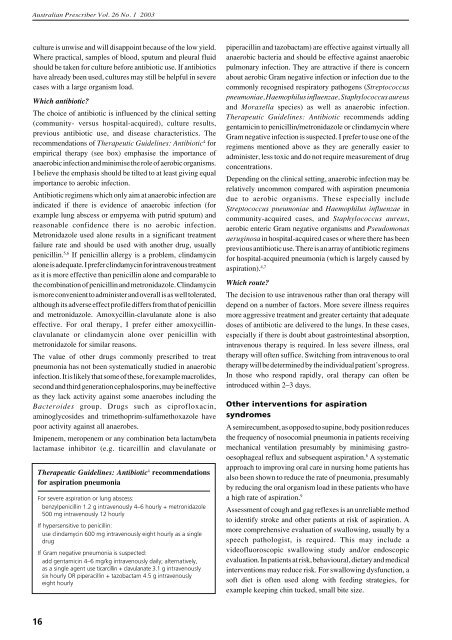Aspiration pneumonia and pneumonitis - Australian Prescriber
Aspiration pneumonia and pneumonitis - Australian Prescriber
Aspiration pneumonia and pneumonitis - Australian Prescriber
Create successful ePaper yourself
Turn your PDF publications into a flip-book with our unique Google optimized e-Paper software.
<strong>Australian</strong> <strong>Prescriber</strong> Vol. 26 No. 1 2003<br />
culture is unwise <strong>and</strong> will disappoint because of the low yield.<br />
Where practical, samples of blood, sputum <strong>and</strong> pleural fluid<br />
should be taken for culture before antibiotic use. If antibiotics<br />
have already been used, cultures may still be helpful in severe<br />
cases with a large organism load.<br />
Which antibiotic?<br />
The choice of antibiotic is influenced by the clinical setting<br />
(community- versus hospital-acquired), culture results,<br />
previous antibiotic use, <strong>and</strong> disease characteristics. The<br />
recommendations of Therapeutic Guidelines: Antibiotic 4 for<br />
empirical therapy (see box) emphasise the importance of<br />
anaerobic infection <strong>and</strong> minimise the role of aerobic organisms.<br />
I believe the emphasis should be tilted to at least giving equal<br />
importance to aerobic infection.<br />
Antibiotic regimens which only aim at anaerobic infection are<br />
indicated if there is evidence of anaerobic infection (for<br />
example lung abscess or empyema with putrid sputum) <strong>and</strong><br />
reasonable confidence there is no aerobic infection.<br />
Metronidazole used alone results in a significant treatment<br />
failure rate <strong>and</strong> should be used with another drug, usually<br />
penicillin. 5,6 If penicillin allergy is a problem, clindamycin<br />
alone is adequate. I prefer clindamycin for intravenous treatment<br />
as it is more effective than penicillin alone <strong>and</strong> comparable to<br />
the combination of penicillin <strong>and</strong> metronidazole. Clindamycin<br />
is more convenient to administer <strong>and</strong> overall is as well tolerated,<br />
although its adverse effect profile differs from that of penicillin<br />
<strong>and</strong> metronidazole. Amoxycillin-clavulanate alone is also<br />
effective. For oral therapy, I prefer either amoxycillinclavulanate<br />
or clindamycin alone over penicillin with<br />
metronidazole for similar reasons.<br />
The value of other drugs commonly prescribed to treat<br />
<strong>pneumonia</strong> has not been systematically studied in anaerobic<br />
infection. It is likely that some of these, for example macrolides,<br />
second <strong>and</strong> third generation cephalosporins, may be ineffective<br />
as they lack activity against some anaerobes including the<br />
Bacteroides group. Drugs such as ciprofloxacin,<br />
aminoglycosides <strong>and</strong> trimethoprim-sulfamethoxazole have<br />
poor activity against all anaerobes.<br />
Imipenem, meropenem or any combination beta lactam/beta<br />
lactamase inhibitor (e.g. ticarcillin <strong>and</strong> clavulanate or<br />
Therapeutic Guidelines: Antibiotic 4 recommendations<br />
for aspiration <strong>pneumonia</strong><br />
16<br />
For severe aspiration or lung abscess:<br />
benzylpenicillin 1.2 g intravenously 4–6 hourly + metronidazole<br />
500 mg intravenously 12 hourly<br />
If hypersensitive to penicillin:<br />
use clindamycin 600 mg intravenously eight hourly as a single<br />
drug<br />
If Gram negative <strong>pneumonia</strong> is suspected:<br />
add gentamicin 4–6 mg/kg intravenously daily; alternatively,<br />
as a single agent use ticarcillin + clavulanate 3.1 g intravenously<br />
six hourly OR piperacillin + tazobactam 4.5 g intravenously<br />
eight hourly<br />
piperacillin <strong>and</strong> tazobactam) are effective against virtually all<br />
anaerobic bacteria <strong>and</strong> should be effective against anaerobic<br />
pulmonary infection. They are attractive if there is concern<br />
about aerobic Gram negative infection or infection due to the<br />
commonly recognised respiratory pathogens (Streptococcus<br />
<strong>pneumonia</strong>e, Haemophilus influenzae, Staphylococcus aureus<br />
<strong>and</strong> Moraxella species) as well as anaerobic infection.<br />
Therapeutic Guidelines: Antibiotic recommends adding<br />
gentamicin to penicillin/metronidazole or clindamycin where<br />
Gram negative infection is suspected. I prefer to use one of the<br />
regimens mentioned above as they are generally easier to<br />
administer, less toxic <strong>and</strong> do not require measurement of drug<br />
concentrations.<br />
Depending on the clinical setting, anaerobic infection may be<br />
relatively uncommon compared with aspiration <strong>pneumonia</strong><br />
due to aerobic organisms. These especially include<br />
Streptococcus <strong>pneumonia</strong>e <strong>and</strong> Haemophilus influenzae in<br />
community-acquired cases, <strong>and</strong> Staphylococcus aureus,<br />
aerobic enteric Gram negative organisms <strong>and</strong> Pseudomonas<br />
aeruginosa in hospital-acquired cases or where there has been<br />
previous antibiotic use. There is an array of antibiotic regimens<br />
for hospital-acquired <strong>pneumonia</strong> (which is largely caused by<br />
aspiration). 4,7<br />
Which route?<br />
The decision to use intravenous rather than oral therapy will<br />
depend on a number of factors. More severe illness requires<br />
more aggressive treatment <strong>and</strong> greater certainty that adequate<br />
doses of antibiotic are delivered to the lungs. In these cases,<br />
especially if there is doubt about gastrointestinal absorption,<br />
intravenous therapy is required. In less severe illness, oral<br />
therapy will often suffice. Switching from intravenous to oral<br />
therapy will be determined by the individual patient’s progress.<br />
In those who respond rapidly, oral therapy can often be<br />
introduced within 2–3 days.<br />
Other interventions for aspiration<br />
syndromes<br />
A semirecumbent, as opposed to supine, body position reduces<br />
the frequency of nosocomial <strong>pneumonia</strong> in patients receiving<br />
mechanical ventilation presumably by minimising gastrooesophageal<br />
reflux <strong>and</strong> subsequent aspiration. 8 A systematic<br />
approach to improving oral care in nursing home patients has<br />
also been shown to reduce the rate of <strong>pneumonia</strong>, presumably<br />
by reducing the oral organism load in these patients who have<br />
a high rate of aspiration. 9<br />
Assessment of cough <strong>and</strong> gag reflexes is an unreliable method<br />
to identify stroke <strong>and</strong> other patients at risk of aspiration. A<br />
more comprehensive evaluation of swallowing, usually by a<br />
speech pathologist, is required. This may include a<br />
videofluoroscopic swallowing study <strong>and</strong>/or endoscopic<br />
evaluation. In patients at risk, behavioural, dietary <strong>and</strong> medical<br />
interventions may reduce risk. For swallowing dysfunction, a<br />
soft diet is often used along with feeding strategies, for<br />
example keeping chin tucked, small bite size.

















